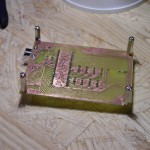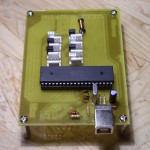This weekend I etched a board for the excellent MJoy16-C1 controller board that I have mentioned in the past. This board is a USB joystick on steroids, supporting up to 8 axis, 64 push buttons, 16 toggle switches and a POV hat. The creator (Mindaugas Milasauskas) seems to have dropped from the net and the old domain is now a search farm. There is one website selling these online for the tidy sum of 199EUR. I found a good mirror of the old project page and downloaded the docs and hex file there. Update: This mirror is now gone as well. 🙁
I have had good luck using the toner transfer method of etching PCBs. Google it for a lot of sites with step by step details on the method. This etch wasn’t the cleanest I have done (I forgot to use photo paper and used regular printer paper), but was functional. I didn’t bother populating the parts for the ISP port, hence the blank area beside the USB connector. The jumpers on the white headers prevent false readings from unconnected axis. I had all the parts on hand with the exception of a 40-pin header for the digital inputs. Now I am one step closer to a functional panel.


